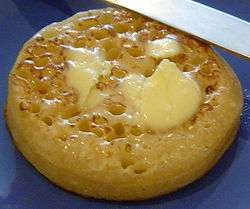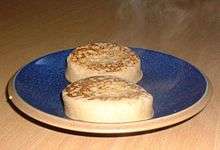Crumpet
 A buttered crumpet | |
| Alternative names | Pikelet |
|---|---|
| Type | Bread |
| Place of origin | or England |
| Main ingredients | Flour, yeast |
A crumpet /ˈkrʌmpɪt/ (![]()
Crumpets are regionally known as pikelets, a name also applied to a thinner, more pancake-like griddle cake:[1] a type of the latter is referred to as a crumpet in Scotland.
History and etymology
Crumpets have been variously described as originating in Wales[2] or as part of the Anglo-Saxon diet,[3] based on proposed etymologies of the word. In either case breads were, historically, commonly cooked on a griddle whererever bread ovens were not available. The bara-planc, or griddle bread, baked on an iron plate over a fire, was part of the everyday diet in Wales until the 19th century.[4] Small, oval cakes baked in this manner were called picklets,[4] a name used for the first recognisable crumpet-type recipe, published in 1769 by Elizabeth Raffald in The Experienced English Housekeeper.[5] This name was derived from the Welsh bara pyglyd or "pitchy [i.e. dark or sticky] bread", later shortened simply to pyglyd;[6][7] the name was of some antiquity as the early 17th century lexicographer, Randle Cotgrave, spoke of "our Welsh barrapycleds".[8]
The word spread initially to the West Midlands of England, where it became anglicised as pikelet,[9] and subsequently to Cheshire, Lancashire, Yorkshire, and other areas of the north; crumpets are still referred to as pikelets in some areas. The word crumpet itself, of unclear origin, first appears in relatively modern times; it has been suggested as referring to a crumpled or curled-up cake, based on an isolated 14th century reference to a "crompid cake",[10] and the Old English word crompeht ("crumpled") being used to gloss Latin folialis, possibly a type of thin bread.[3] Alternatively, crumpet may be related to the Welsh crempog or crempot, a type of pancake.[2] An etymology from the French language term crompâte, meaning "a paste of fine flour, slightly baked"[11] has also been suggested. However, a correspondent to Manchester Notes and Queries, writing in 1883, claimed that the crampet, as it was locally then known, simply took its name from the metal ring or "cramp" used to retain the batter during cooking.[12]
The early crumpets were hard pancakes cooked on a griddle, rather than the soft and spongy crumpets of the Victorian era, which were made with yeast.[10] From the 19th century a little bicarbonate of soda was also usually added to the batter.[5] In modern times, the mass production of crumpets by large commercial bakeries has eroded some regional differences. As late as the 1950s Dorothy Hartley noted a wide degree of regional variation, identifying the small, thick, spongy type of crumpet specifically with the Midlands.[5]
Characteristics

Crumpets are distinguished from similar sized muffins by being made from a batter, rather than a dough.[13] English crumpets are generally circular, roughly 8 centimetres (3 in) in diameter and 2 centimetres (3⁄4 in) thick. Their shape comes from being restrained in the pan/griddle by a shallow ring. They have a characteristic flat top with many small pores and a spongy texture which allows the butter or other spread to permeate it.
Crumpets may be cooked until ready to eat warm from the pan, but are also left slightly undercooked and then toasted. While premade commercial versions are available in most supermarkets, freshly home-made crumpets are less heavy and doughy in texture.[14] They are usually eaten with a spread of butter, or with other sweet or savoury toppings.
While in some areas of the country the word pikelet is synonymous with the crumpet,[1] in others (such as Staffordshire and Yorkshire) it refers to a slightly differing recipe. If differentiated from the crumpet, a pikelet is defined as containing no yeast as a raising agent and as being cooked without a ring, making it rather flatter or thinner than a crumpet,[6][5][15] and a thinner batter was also used.[15] In Stoke-on-Trent, pikelets were once sold in the town's many oatcake shops.[16] A 1932 recipe for Staffordshire pikelets specifies that they were made with flour and buttermilk, with bicarbonate of soda as a raising agent, and suggests cooking them using bacon fat.[17]
The term pikelet is used in Australian and New Zealand cuisine for a similarly flat cake, of the type that, in Scotland and North America, would be called a pancake and, in England, a Scotch pancake, girdle or griddle cake, or drop scone.[18]
Scottish crumpet

A Scottish crumpet is broadly similar to the pikelet of parts of northern England. It is made from the same ingredients as a Scotch pancake, and is about 180 millimetres (7 in) diameter and 8 millimetres (0.3 in) thick. It is available plain, or as a fruit crumpet with raisins baked in, usually fried in a pan and served with a fried breakfast. It is also sometimes served with butter and jam. The ingredients include a leavening agent, usually baking powder, and different proportions of eggs, flour, and milk which create a thin batter. Unlike a pancake, it is cooked to brown on one side only, resulting in a smooth darker side where it has been heated by the griddle, then lightly cooked on the other side which has holes where bubbles have risen to the surface during cooking.[19]
This is the normal kind of crumpet in Scottish bakers' shops, tea rooms, and cafés, though the English type of crumpet is always obtainable in supermarkets in addition to the Scottish kind.
The South African version of the crumpet, a popular dessert and breakfast treat, is almost identical to the Scottish recipe.[20]
See also
References
- 1 2 Ingram, Christine (1999). The Cook's Guide to Bread. Hermes. p. 50.
- 1 2 Shulman, Martha (1995). Great Breads. Houghton Mifflin. p. 240.
- 1 2 Ann Hagen, A Handbook of Anglo-Saxon Food Processing and Consumption, 1992, p. 20
- 1 2 Notes & Queries, 3rd. ser. VII (1865), 170
- 1 2 3 4 Davidson, A. The Penguin Companion to Food, 2002, p. 277
- 1 2 Edwards, W. P. The Science of Bakery Products, Royal Society of Chemistry, 2007, p. 198
- ↑ Luard, E. European Peasant Cookery, Grub Street, 2004, p. 449
- ↑ The folk-speech of south Cheshire, English Dialect Society, 1887, p. 293
- ↑ Wilson, C. A. Food & drink in Britain, Barnes and Noble, 1974, p. 266
- 1 2 John Ayto (18 October 2012). The Diner's Dictionary: Word Origins of Food and Drink. Oxford University Press. pp. 106–107. ISBN 978-0-19-964024-9.
- ↑ Notes & Queries, 16 (1850), 253
- ↑ City News Notes and Queries, vol. V, (1883), 33 ("In Lancashire there are muffins, crampets, and pikelets. The crampet is so called because the batter is poured into a circular metal ring or "cramp" for baking, and the size is that of an ordinary tea-saucer".)
- ↑ Braun, Emil (1901). The Baker's Book: A Practical Hand Book of the Baking Industry in All Countries, vol 1. p. 196.
- ↑ Ingram (1999), p.144
- 1 2 Banfield, Walter (1947). Manna: A Comprehensive Treatise on Bread Manufacture. Maclaren & Sons. p. 444.
- ↑ Hopkins, Harry (1957). England is Rich. G.G. Harrap. p. 100.
- ↑ Byron, May (1932). Pot-luck. Hodder & Staughton. p. 359.
- ↑ The Concise Household Encyclopedia (ca. 1935) Fleetway House, The Amalgamated Press, London
- ↑ Traditional Scottish Recipes - Scottish Crumpets
- ↑ South African Crumpet Recipe
External links
| Look up crumpet in Wiktionary, the free dictionary. |
- Description and recipe on history.uk at the Wayback Machine (archived February 16, 2011)